Good day, dear readers. Today, We will tell you about the temples of Bali. It is often said that there are more temples per square mile in Bali than anywhere else in the world. And this could very well be true. There are hundreds of thousands of temples on the island, far more than the twenty thousand often written in guidebooks. All residents of Bali, regardless of caste or status, must visit village temples. What kind of temples are there in Bali? Balinese temples can be very different: family, village, royal. Temples of rice fields, mountains (pura bukit), caves (pura goa), water (pura tirta), river, sea (pura segara). There are temples dedicated to spirits that protect agriculture (pura subak), or temples for markets (pura melanting). Temples dedicated to certain gods or goddesses, trees, rocks. And so on and so forth.
Regular ceremonies are held in each of these temples. A temple always has a main deity or direction of work, and it may also have a sanctuary associated with its immediate deity. For example, the main goddess worshipped in the market temple is Maya, who is also the goddess of illusion. In the market temple, offerings may also be made to the goddess Devi Sri, who is the goddess of rice. After all, rice is sold in the market, and it is also important for the market to always have an abundance of rice. Thus, the goddess Devi Sri will receive offerings in both the rice temple and the market temple. There has been some connection between the goddess of rice and the goddess of the market. 🙂
Or Ulun Danu Batur temple, where three deities are worshipped at once, the spirit of Mount Batur, Mount Agung, and the water goddess of Ulun Danu.
Not only temples can be sacred places on the island of Bali. Trees can be sacred. Rocks can be sacred. Caves. Mountains. Places where sacred objects are located also become sacred. There are a huge number of sacred places in Bali, and that is very pleasing, of course. 🙂
The temples of Bali, known as Pura, are sacred places of worship that play a significant role in the daily lives of Balinese people. There are thousands of temples and shrines spread throughout the island, with each one dedicated to specific deities, spirits, or ancestors. The most important temples are the ones that make up the Sad Kahyangan Jagad, also known as the Six Great Temples, which are considered the spiritual pillars of Bali. These temples include Pura Besakih, Pura Uluwatu, Pura Luhur Lempuyang, Pura Batukaru, Pura Andakassa, and Pura Ulan Danu Batur. Each temple holds regular ceremonies to honor its respective deities, and they all celebrate their anniversary or Odalan every 210 days. These celebrations involve gamelan orchestras, traditional dances, and ceremonial offerings. In addition to temples, other natural features such as trees, rocks, and caves can also be considered sacred places in Bali.
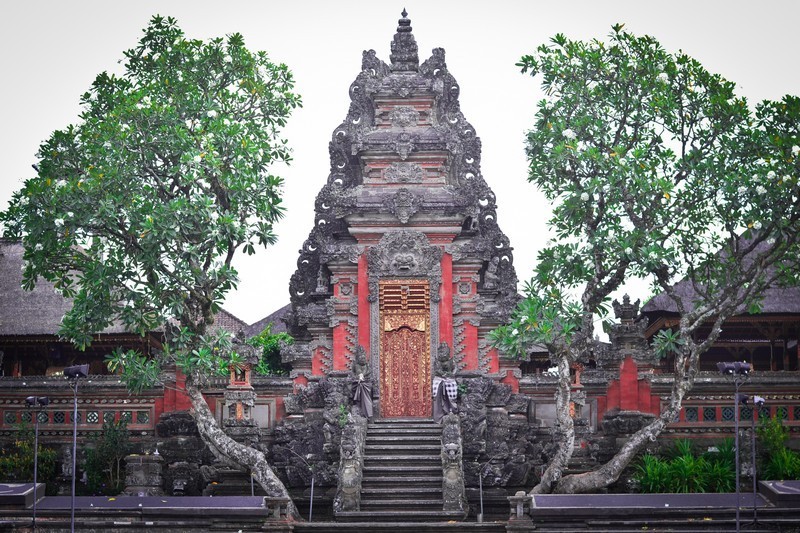
The stairs are guarded by naked snakes, and often there are guards near the gates – these are statues with powerful clubs and intimidating faces that clearly indicate to us that those with bad thoughts will not be allowed into the temple.
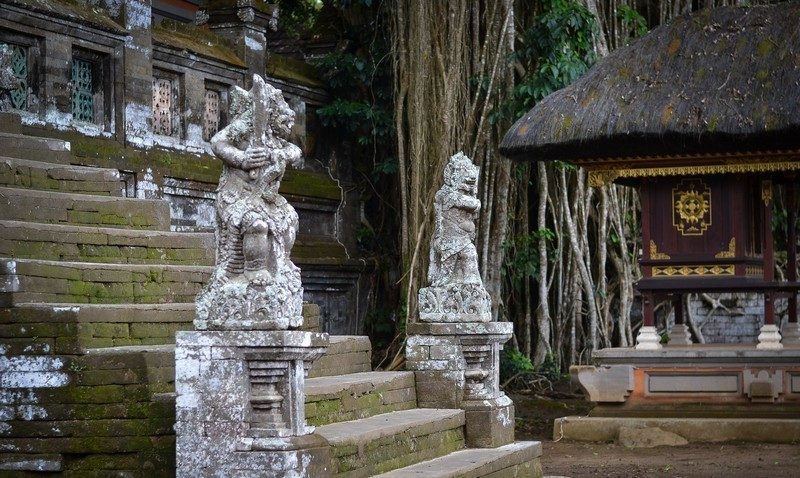
The inner content of the temple is divided into three sections, the outer (for people), middle (dialogue between humans and deities, preparation), and inner (most sacred, where one communicates with gods). Or: Nista mandala (jaba pisan) Madya mandala (jaba tengah) Utama mandala (jero). The first zone of the temple, called jaba pisan, is intended for people, where they greet the temple space, eat, communicate, watch dances, performances, listen to music, as shown in the video below. The middle part of the temple, called jaba tengah, is a transitional space between the human realm and the divine world, where pavilions are located for preparing offerings before they are accepted into the “holy of holies”.
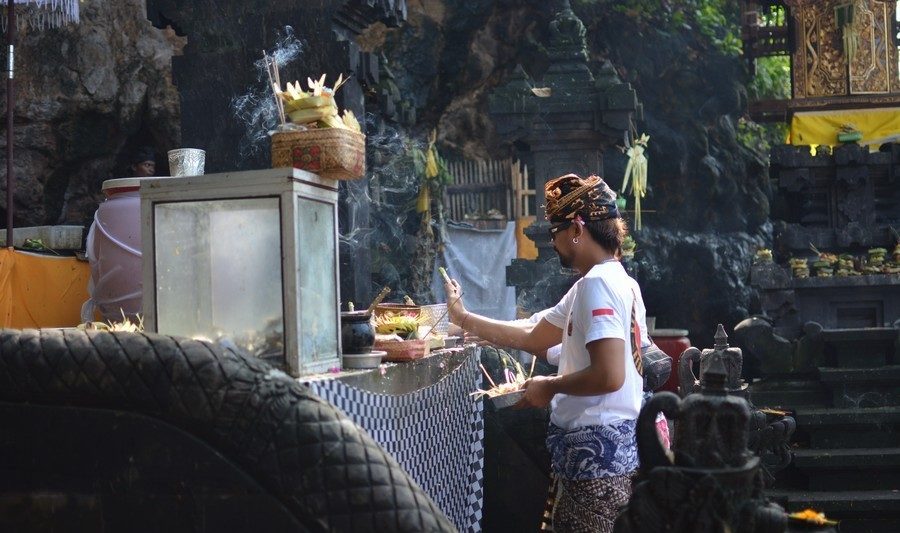
Before the ceremony begins, people can laugh, joke, and talk about trivial topics. The holy of holies zone, where communication with the divine or prayer takes place, is called jeroan. This space is located slightly higher than the other zones and is situated closer to the mountains (kaja).

The images on the walls of the temple follow the same pattern: at the top of the walls are symbols of gods and the upper world. In the center are scenes from the human world. At the bottom are images of snakes. The symbol of the snake represents the foundation of the world in Balinese mythology.
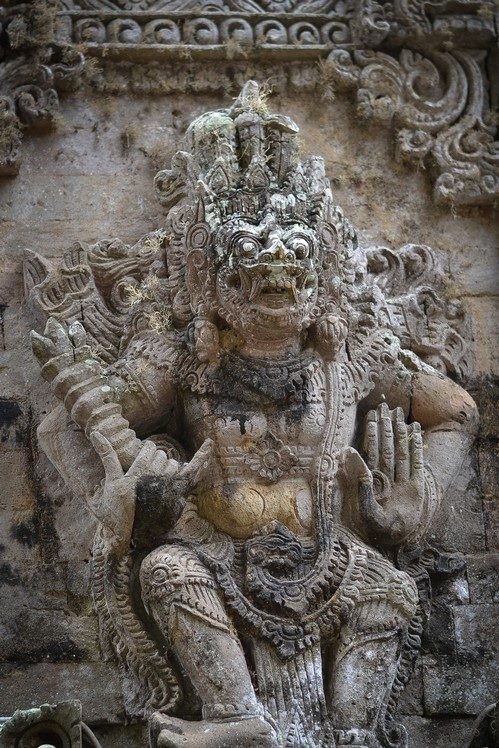
Buildings on the temple grounds in Bali:
Kulkul drum. Public temples have a hollow log Kulkul with a hammer hanging next to it. Since ancient times, it has been used to call villagers for ceremonies or to warn of disasters. For example, a double sound indicated that someone had been robbed in the village. The Kulkul is located in the corner of the middle section of the temple in a special pavilion. Empty throne or seat (Padmasana).
Padmasana is found in public and family temples. Literally translated as “place for the lotus.” Padmasana is considered the throne of the supreme god Ida Sang Hyang Widhi Wasa. In some temples, Padmasana is used as a throne for Shiva and other deities. It is believed that the Javanese priest Nirartha or Pedanda Sakti Wawu Rauh, who arrived in Bali in the 15th century and brought Hinduism with him, invented Padmasana. “Padma” is translated as “lotus,” which is a symbol of purity in Hinduism.
Pavilions for various needs Bale (bale). Bale pawedan – pavilion for music and singing, Bale palegongan – a place for dance performances, gedong penyimpenan – relics of the temple are kept here, bale panggungan and bale pepelik – a place for offerings, bale agung – a place for meetings, bale piyasan – a pavilion for priests, bale pawedan – where high-level Brahmins create holy water. And so on, pavilions can serve different functions.
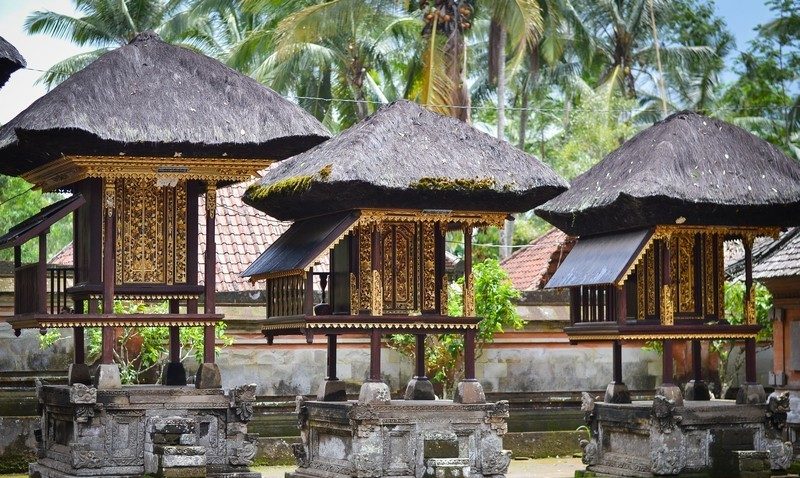
Buildings on the temple grounds in Bali: Lingga.
The elongated and rounded Lingga at the top represents the phallus of Shiva. Linggas can be found in temples and sacred places. Meru pagodas (merus). These sanctuaries are symbols of the mythical Mount Meru in the center of the universe, which is the home of the gods.
Meru pagodas are also the abodes of the gods, which they visit during temple ceremonies. Balinese Meru pagodas always have an odd number of tiers, from 1-11. The higher the Meru, the higher the status to whom it is dedicated: eleven tiers for Shiva, Brahma, or the supreme god on Bali – Sanghyang Widhi Wasa. The tiers of the Meru tower in family temples may indicate the caste of the family. Sudras have 1-3 tiers, aristocrats have 5-9 tiers, while Brahmins and kings have eleven.
Kahyangan Tiga, or the three great temples of each village, are the following three temples that exist in every village on the island. They are called Kahyangan Tiga or the Three Great Temples. As legend has it, they were initiated by Empu Kuturan, a legendary Javanese priest, in the 11th century:
1. Pura Puseh – This temple is dedicated to the founders of the village (ancestors) and the god Vishnu. The main “Pura Puse” temple, which is considered to be the place where the souls of ancestors are located, is located in the village closest to the mountains (kaja).
2. Pura Desa – “Pura Bale Agung” or “Pura Desa” is a temple of daily worship of the gods, located in the center of the village. This temple is dedicated to the affairs of the village and is dedicated to the god Brahma.
3. Pura Dalem – “Pura Dalem” is dedicated to the souls of the deceased, and the main deity here is Shiva. Pura Dalem is built facing the sea (kelod).
*There are also temples called Pura mrajapati, which are also responsible for the “world of the departed”, but for those who have not yet been cremated, such temples are built near the cemetery.
The temple anniversary – Odalan-Every temple has a celebration of its anniversary, which takes place every Balinese year, which is every 210 days. Odalan is a very important event for the temple because during the 210-day cycle, heavy energy, thoughts, and feelings may accumulate in the sacred space of the temple. Odalan can be symbolically understood as a kind of rebooting of the temple, it takes place with a gamelan orchestra, beautiful dances and ceremonial performances from Hindu scriptures. The temple anniversary can take place on a full moon (purnama) or on a new moon day (tilem). Most temple anniversaries last three days.
Sad Kahyangan Jagad – the Six Sacred Temples of Bali. Bali has six ancient and historic sacred temples known as Sad-Kahyangan or the Six Great Temples. According to Balinese beliefs, these temples are called “the six earthly sanctuaries” and serve as the pillars of spiritual balance in Bali. They are believed to protect the entire island and its inhabitants. Different sources and regions in Bali have various versions of the Six Sacred Temples, sometimes extending to nine, but there is also a separate concept of nine guardian temples oriented to the cardinal points of the island, which we will discuss below. We conducted our own research and identified the following temples that are included in the Great Six. It is said that all the sacred temples are located on hills or mountains, according to their predestined locations.
Pura Besakih,
Pura Uluwatu,
Pura Luhur Lempuyang,
Pura Batukaru, Pura
Andakassa,
and Pura Ulan Danu Batur.
The nine protective temples of Bali, guarding the island from evil spirits, are:
Pura Besakih on Mount Agung (center);
Pura Goa Lawah (southeast);
Pura Lempuyang Luhur on Mount Lempuyang (east);
Pura Luhur Batukaru near Mount Batukaru (west);
Pura Luhur Uluwatu on the Bukit Peninsula (southwest);
Pura Masceti near Gianyar (south);
Pura Pasar Agung on Mount Agung (northeast);
Pura Ulun Danu Batur on the edge of the large caldera (north);
Pura Ulun Danu Bratan on Lake Beratan (northwest).

